How to Use Drip Nurturing to Convert More Leads

Sorry, there were no results found for “”
Sorry, there were no results found for “”
Sorry, there were no results found for “”

Most leads don’t convert right away.
They browse your landing page, maybe download a free resource, and then crickets. 🦗🦗🦗
It’s not that they’re not interested.
They’re just not ready, yet. That’s where drip-nurturing campaigns keep things moving.
Instead of relying on one-off emails or cold follow-ups, drip nurturing helps you stay in touch with leads in a timely and valuable way.
If you’re looking to improve your conversion rates and quality your leads smartly, we’re here to help.
We share everything you need to know about drip nurturing: why you need it, the key elements of a successful drip nurturing campaign, and how to build your drip nurture campaign using ClickUp.
From marketing emails to post-purchase emails, we’ll look every touchpoint!
Drip nurturing is where you send a series of pre-planned, automated messages—usually emails—over time to guide prospects through their buying journey.
Unlike one-off campaigns or blasts, drip nurturing is sequenced. It responds to where a person is in their decision process and delivers content in logical, timed intervals. The goal is to educate, build trust, and nudge them closer to conversion, without overwhelming them.
Drips are often triggered by behavior (like downloading a guide or abandoning a cart) or by stage (e.g., new subscriber vs. returning lead). Done right, they feel like helpful follow-ups, not spam.
If you’re looking to re-engage inactive leads or former subscribers and existing customers, the ClickUp Drip Campaign Template helps you out. You can launch drip campaigns easily, track performance at each stage of the funnel, and optimize your efforts.
This Doc template includes:
Most leads and your target audience aren’t ready to buy the moment they find you. They’re browsing. Comparing. Maybe just testing the waters.
🧠 Did You Know? 73% of survey respondents in a Demand Gen Report noted that the No. 1 benefit of lead nurture programs is generating warmer, more sales-ready leads.
So what happens if you reach out once and then go silent? Simple, they forget you exist.
That’s why drip nurturing is a conversion lifeline. It keeps your brand in your lead’s inbox (and mind), builds trust over time, and positions you as the obvious choice when they’re ready to take action.
Drip nurturing helps you turn interest into action by:
As per the same lead generation and acceleration survey from Demand Gen Report, the additional benefits of a lead nurture program include:
Before you build your drip sequence, you need to get the fundamentals right. The most effective drip-nurturing campaigns are built on six core elements. Let’s break them down.
Every campaign should have one specific objective. It could be to book a demo, drive signup, and re-engage inactive leads. Define your end goal before starting your campaign, because if you’re not clear on the goal, neither is your audience.
💡 Pro Tip: If this is your first email nurture campaign, we recommend you start by filling out all the necessary details in a drip campaign template. This is a huge timesaver since you don’t have to think from scratch. The template has custom statuses, custom fields, and custom views, so you can plug and play your information and get started.
Every lead is on a different path; some are just exploring, while others are almost ready to convert. Segment your audience by interests, behaviors, and stage in the buying process to deliver hyper-personalized messages that truly resonate and encourage repeat purchases.
👀 Did You Know? Segmented campaigns experience a 23% higher open rate and a 49% higher click-through rate than non-segmented campaigns.
As part of a well-rounded email marketing strategy, create content that educates, inspires, or solves a specific problem your lead is facing. The goal is to build trust and demonstrate expertise, not just pitch your product. When your emails help leads make better decisions, conversion will follow.
Not every drip email needs to be a hard pitch. Instead, aim to:
Timing can make or break your campaign. In email drip marketing campaigns, you need to space out emails to avoid overwhelming your audience. Also, align each message with where the lead is in their decision-making process. It could be awareness, consideration, or purchase to enhance customer satisfaction.
That said, don’t blast emails to your leads. Give them some time to breathe.
Map your drip and nurture campaign to the buyer’s journey:

Bonus: If your team struggles to manage sequences, timing, or follow-ups across multiple campaigns, explore these email management software tools to streamline everything in drip marketing from scheduling to segmentation.
🌻 Fact Check: Personalization is now expected, not optional. According to a McKinsey report, 71% of consumers expect companies to deliver personalized interactions.
In other words, drip campaigns that lack personalization feel like noise. When prospects receive generic content, they mentally tune out.
Personalization in drip nurturing—like using behavioral triggers, tailoring content to user intent, or referencing prior interactions—meets this new baseline of expectation. It’s the difference between an ignored sequence and an open, engaged one.
So, how do you build drip campaigns that feel personal, not robotic? Start here👇:
📮 ClickUp Insight: 1 in 4 employees uses four or more tools just to build context at work.
A key detail might be buried in an email, expanded in a Slack thread, and documented in a separate tool, forcing teams to waste time hunting for information instead of getting work done. ClickUp converges your entire workflow into one unified platform. With features like ClickUp Email Project Management, ClickUp Chat, ClickUp Docs, and ClickUp Brain, everything stays connected, synced, and instantly accessible. Say goodbye to “work about work” and reclaim your productive time.
💫 Real Results: Teams are able to reclaim 5+ hours every week using ClickUp—that’s over 250 hours annually per person—by eliminating outdated knowledge management processes. Imagine what your team could create with an extra week of productivity every quarter!
The most successful drip-nurture campaigns are the ones that listen and adapt. Your first version isn’t your best. Treat it like your baseline.
Feedback and optimization are integral parts of marketing campaign management. Pay close attention to whether leads are engaging.
For starters, email marketing KPIs like open rates, click-through rates, reply rates, and unsubscribes tell one part of the story.
But so do qualitative signals: Are leads replying with objections? Are they converting too late? Or not at all?
Optimize your drip nurture campaign with these levers:
📖 Read More: Best Influencer Templates to Manage Outreach
Here’s a complete walkthrough of how to build a drip-nurturing workflow that delivers results.
Start with one objective. Is this campaign meant to onboard new users, re-engage cold leads, or nudge trial users toward activation?
Next, map your objective against the buyer journey in your drip campaign. Ask yourself:
Align each message in your drip sales funnel with that stage-specific intent.
Here’s a handy table to help match campaign intent with the right buyer stage and asset type in your drip-nurture campaign:
| Objective | Buyer Stage | Drip Content Type |
| Welcome new leads | Awareness | Brand intro, value prop email, short video |
| Re-engage cold leads | Awareness/Interest | Blog roundup, product refresh, soft CTA |
| Nurture MQLs to sales readiness | Consideration | Case study, ROI calculator, product tour |
| Convert trial users | Decision | Onboarding tips, success story, feature guide |
| Drive upsells or cross-sells | Post-Purchase | Advanced use case, upgrade CTA |
| Improve retention | Post-Purchase | How-to content, product updates, community invite |
| Generate referrals/testimonials | Advocacy | NPS survey, referral CTA, thank-you reward |
Use ClickUp Goals to set your nurture campaign’s north star. You can break down the goal (e.g., convert 15% of trial users) into measurable targets like email opens, demo signups, or CTRs.
Assign these targets to the marketing team so progress is always visible. You can even visualize your buyer journey stages and campaign goals centrally and within your marketing calendar before starting with the execution.

📌 Example:
Let’s say your digital marketing team is launching email drip campaigns for free trial users who signed up but haven’t completed onboarding.
Your main objective: Convert 20% of inactive free trial users into active users within 30 days. In ClickUp, you can set this up using a Goal called “Trial User Activation Campaign – Q3” with measurable Targets like:
✅ Send a 5-email onboarding sequence to 100% of inactive trial users
✅ Achieve a 35% average open rate across the sequence
✅ Increase product logins from inactive users by 25%
✅ Convert 20% of trial users to paid plans by campaign end
At this stage, consider using ClickUp’s Marketing Campaign Management Template to get a larger picture of the marketing activities. It offers specialized views for Product Launch, Social Media Tracker Marketing Phase, References, and Budget Tracker to simplify the organization of activities and execution.
Effective nurturing requires precision. Segmentation ensures that your messaging speaks directly to where a lead is in their journey.
Here are some powerful segmentation variables you can use in your email marketing checklist:
For example, leads who downloaded a beginner guide might get educational content, while leads who requested a product demo receive comparison sheets and case studies.
ClickUp makes audience segmentation scalable across teams. With ClickUp Tasks, you can create tasks for each segment’s campaign stream. For example, “Email 1 – Top of Funnel Leads” or “Email 3 – Demo Watchers.”
Use ClickUp Custom Fields like Lead Source, Buyer Stage, or Persona to tag and group these tasks.
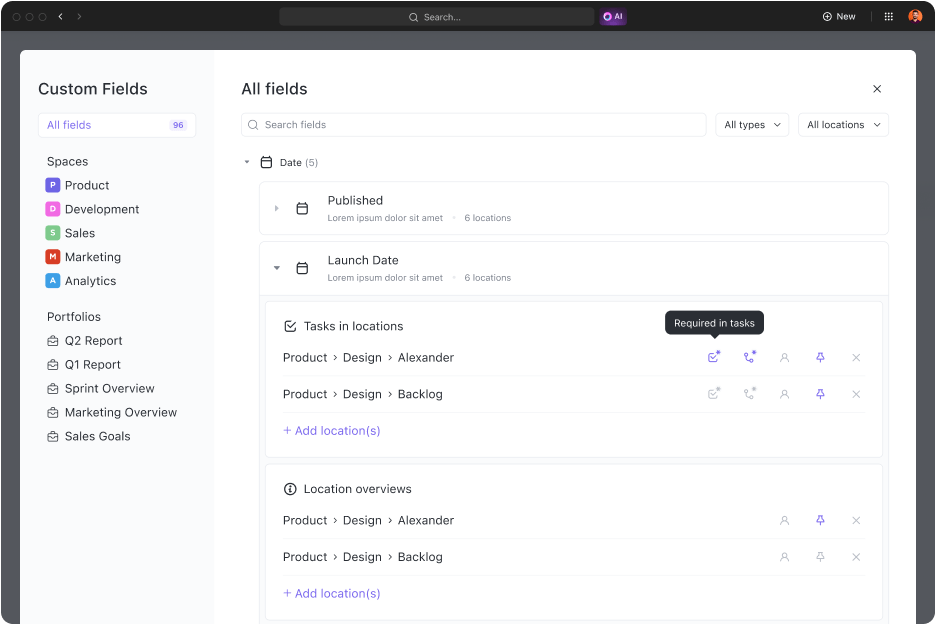
This keeps segmented email streams organized, approvals smooth, and nothing slips through. ClickUp Views allow you to visualize the segmentation plan in a List, Calendar, or Board view to get a real-time snapshot of campaign progress by audience type.

💡 Pro Tip: Manual segmentation is where drip campaigns fall apart. Use customer segmentation tools to auto-tag leads based on behavior, source, or CRM properties and trigger workflows accordingly.
They help you go beyond “email list A vs. B.” You can dynamically group leads by real-time actions, such as who watched a demo, who bounced from pricing, or who hasn’t engaged in 14 days.
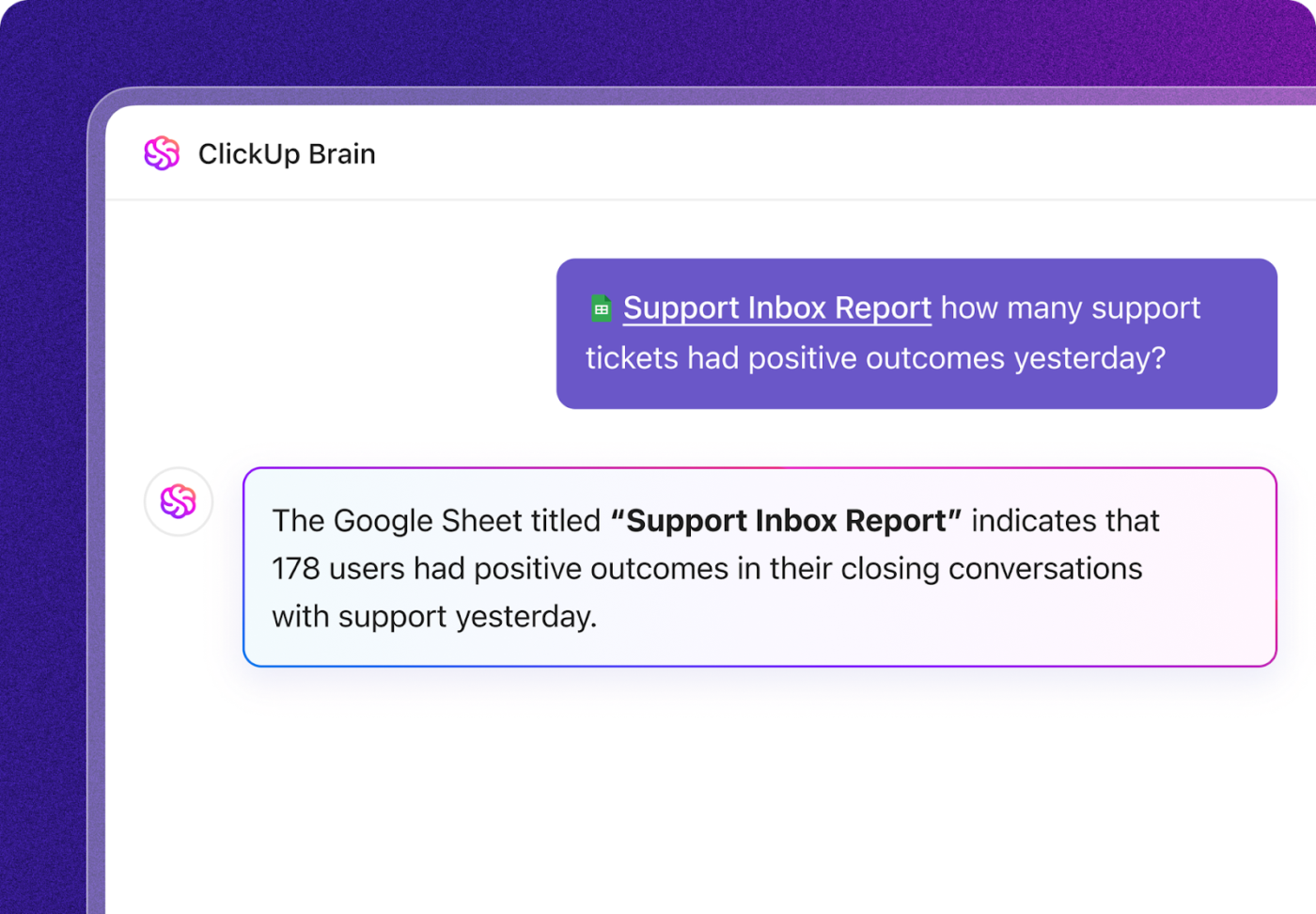
Now it’s time to plan your touchpoints. What story will your emails/messages tell, and in what order?
A basic drdrip-nurturingequence in your email campaign management system will look like:
Each email in your email nurture campaigns should move the lead a step closer to trust and action. Don’t just sell. Share insights, bust myths, offer social proof, and deliver mini-wins.
Use ClickUp Docs to plan and draft your email sequence. Each email can be broken into blocks with content, subject line, target persona, and status (e.g., “in review” or “approved”).
With Assign Comments, each team involved in the email drip campaign can add their suggestions directly to the Doc.
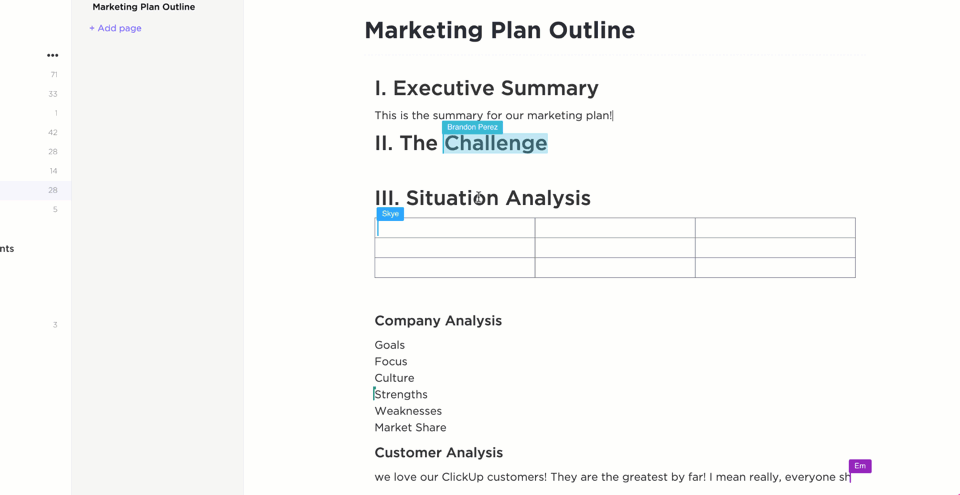
ClickUp Brain is an integral part of your email drip campaign. If you’re already using ClickUp as your CRM for email marketing, Brain helps you in the following ways:

⚒️ Quick Hack: Here are some ClickUp Brain prompts to help you in your email drip campaigns:
Prompt 1: Create a task list for a 5-step email nurture sequence targeting new leads
Prompt 2: Write a follow-up email for leads who downloaded our eBook but haven’t scheduled a demo
Prompt 3: Summarize the last three interactions with Lead X to prepare for a follow-up email
Prompt 4: Set a reminder to follow up with Lead Y three days after they open our pricing page
ClickUp’s Email Project Management provides a comprehensive solution for managing drip-nurture campaigns directly within your CRM. Here are the key features that help you improve your campaigns:
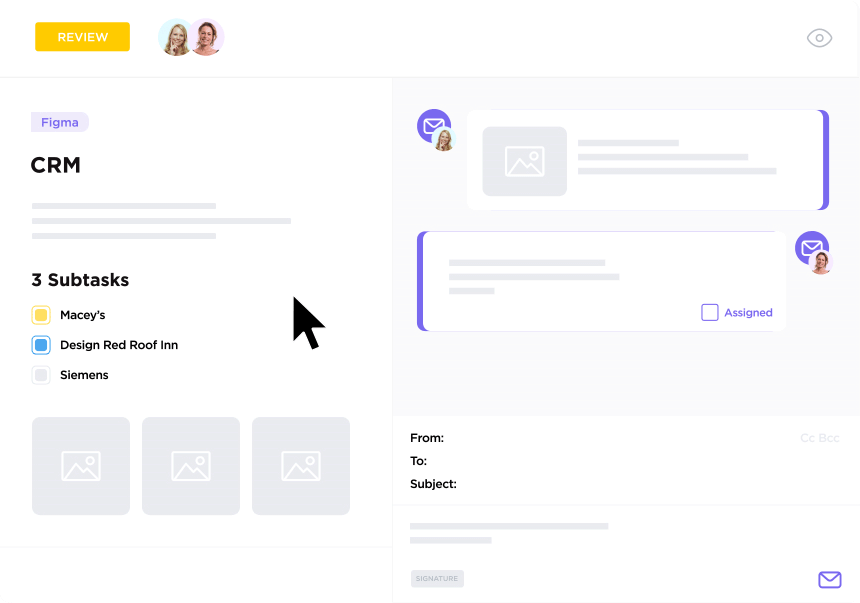
The next step is to break the drip campaign into smaller, executable tasks. This includes:
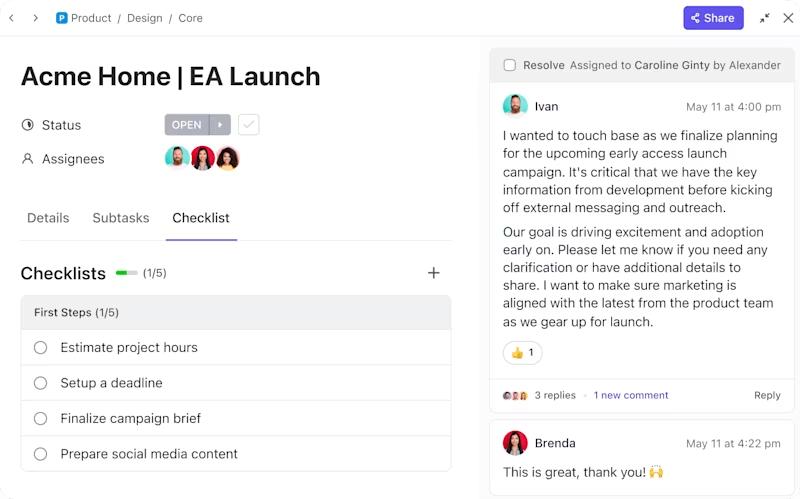
Build your campaign using task hierarchies in ClickUp:

💡 Pro Tip: Name your campaign tasks like “Email 2 – Demo No-Shows” or “Follow-Up – TOFU Leads.” It helps the entire team understand who the message is for and what it’s supposed to do.
Plan your email drip campaign with critical events like product releases or events.
Your planning should include:
At this stage, use ClickUp Calendar View or Timeline View to map out your entire campaign. You can drag and drop tasks to adjust timing, identify overlaps, and view dependencies.
Add milestones for key dates like launch, QA, or major sends. This visual clarity helps you avoid bottlenecks and coordinate cross-team activity.
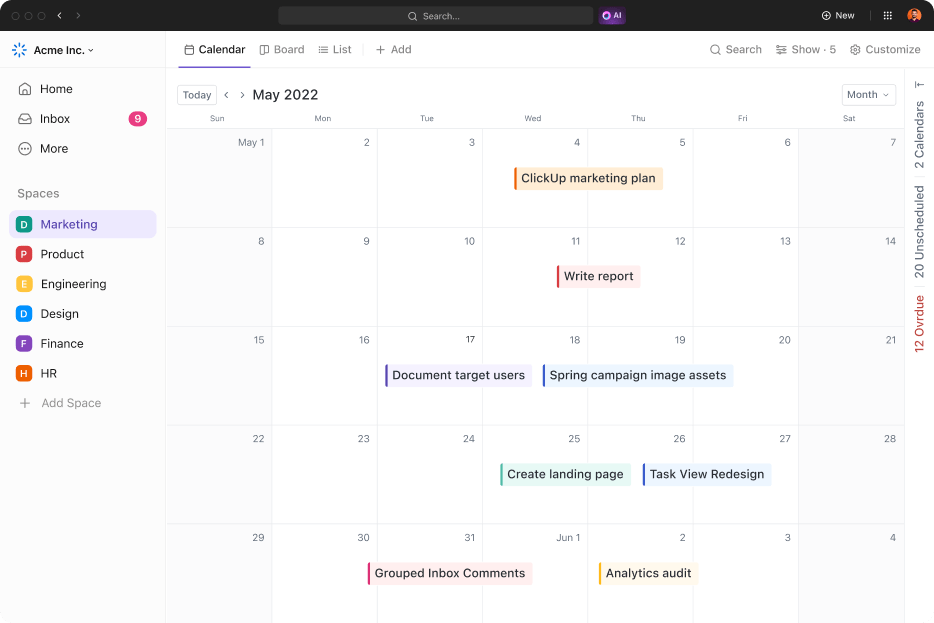
🧠 Fun Fact: After WW I, a proposal for a 13-month calendar with equal 28-day months and a “world holiday” nearly passed. However, religious opposition sank it.
Marketing campaigns are rarely solo missions. You’ll need collaboration between content writers, designers, legal reviewers, and campaign managers. The more seamless this collaboration is, the faster you can ship high-quality work.
ClickUp enables real-time collaboration through task comments, @mentions, and ClickUp Chat. Need feedback from legal? Tag them in the agreement.
Waiting on design tweaks? Start a thread right inside the task.
You can even pin important notes and resolve comments once changes are made. Since everything lives in the task or document itself, no one has to hunt for information.

Launch your campaign using your preferred email platform, but continue tracking and optimizing from inside ClickUp.
You should:
Use ClickUp Dashboards to track campaign performance in real time. Visualize key metrics like open rates, click-throughs, or conversions through customizable widgets.
ClickUp’s Integrations help you connect campaign tasks with CRM data from other tools like HubSpot or Mailchimp and digital marketing apps in your tech stack. This is so that lead activity, potential customers’ touchpoints, and statuses stay in sync.
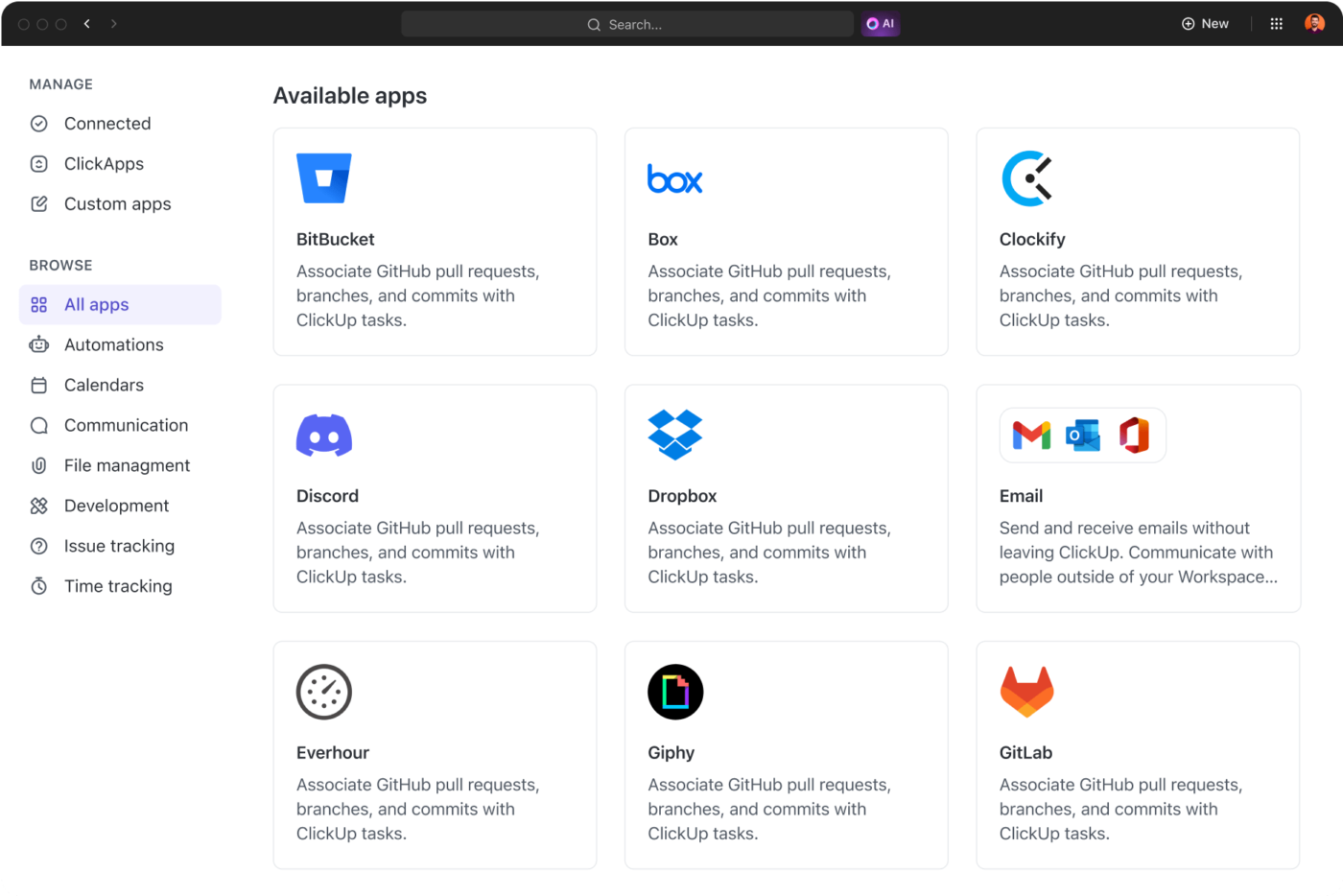
📖 Read More: Best AI Email Marketing Tools to Automate Email
Effective drip nurturing is about delivering the right message at the right moment in the buyer’s journey. Here are four common sequences that high-performing teams use:
Trigger: New lead or sign-up
Goal: Build trust and set expectations
Example Flow:
Trigger: Lead engages with a specific product or landing page
Goal: Drive conversions with urgency
Example Flow:
Trigger: Expiring subscription or dormant user
Goal: Re-activate or retain users
Example Flow:
Trigger: User unsubscribes or becomes inactive
Goal: Recover interest or reduce churn
Example Flow:
These sequences can be customized based on product type, sales funnel, or customer behavior. ClickUp can help plan, assign, and automate each stage, keeping your team aligned and your messaging sharp.
👀 Did You Know? The term “drip marketing” borrows from drip irrigation, a farming technique that delivers small amounts of water to plants over time.
The concept was deemed perfect for marketing drip information to your leads steadily, strategically, and sustainably.
Drip nurturing is most effective when your tools are in sync, from automation to analytics to project management. Here are some tools that support every stage of your drip campaign workflow:
Drip nurturing works best when everything behind the scenes runs smoothly, including your messaging, timing, team coordination, and performance tracking. But you’re likely to make errors when you manage everything over spreadsheets or disjointed tools.
ClickUp brings it all together in one platform. With customizable templates, integrated email management, automation, and real-time dashboards, ClickUp makes it easier to plan, launch, and optimize every step of your campaign.
Sign up for ClickUp today and simplify the way you nurture leads.
© 2025 ClickUp